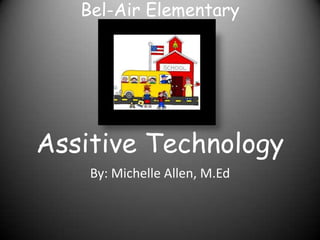
Bel-Air Elementary Assistive Tech for Learning
- 1. Bel-Air Elementary Assitive Technology By: Michelle Allen, M.Ed
- 2. What is Assistive Learning? • Assistive Technology is an umbrella term that includes assistive, adaptive, and rehabilitative devices for people with disabilities and also includes the process used in selecting, locating, and using them. • AT promotes greater independence by enabling people to perform tasks that they were formerly unable to accomplish, or had great difficulty accomplishing
- 3. Types of Disabilities • Physical Disabilities – Hearing – Loss of limb use – Vision impairment • Learning Disabilities – Undiagnosed Gifted learners – ADHD – Dyslexia
- 4. Dragon Naturally Speaking • Dragon Naturally speaking 11 is a speech to text program for students who need assistance with typing papers or completing work for class. • It is helpful for students who have limited physical mobility, students who have Dyslexia or a learning disability, and students who are slower at typing or processing.
- 5. • Gifted Students defined…. – “To define giftedness in children in one concrete manner is very difficult to do. However, what appears to be consistent among those gifted aged six months to eight years old is intrinsic motivation, creativity, exceptional memory, etc. These children have a desire to learn and a craving for knowledge unlike that of others. The way in which they think and the questions that they raise allow a parent to see that their child is on a gifted level.” (Ebner, Jonathan)
- 6. Gifted Students • Tip #1: Familiarize Yourself with the Characteristics of Intellectually Gifted Students • Tip #2: Let Go of "Normal“ • Tip #3: Conduct Informal Assessments • Tip #4: Re-Familiarize Yourself with Piaget & Bloom • Tip #5: Involve Parents as Resource Locators • Tip #6: Learn About Distance Learning Opportunities • Tip #7: Explore Acceleration ~ It's Free and It Works! • Tip #8: Learning from the Experiences of Others http://www.davidsongifted.org/db/Articles_id_10075.aspx
- 7. • The National Institute of Mental Health (NIMH) estimates that 3% to 5% of children have ADHD. Some experts, though, say ADHD may occurs in 8% to 10% of school-aged children. • Children with ADHD generally have problems paying attention or concentrating. They can't seem to follow directions and are easily bored or frustrated with tasks. They also tend to move constantly and are impulsive, not stopping to think before they act.
- 8. Attention Deficit Hyperactive Disorder 1. Understand the struggle a student with ADHD has and provide an ordered, safe, predictable classroom environment. 2. Establish a courteous, working relationship with the student’s parents. Learn about their child’s strengths, weaknesses, interests and achievements outside of school. Ask what teaching methods have been most effective with their child. Communicate often and send encouraging notes home. 3. Make time to speak to the student individually. Be respectful and express interest in his or her success in school by asking how he or she learns best. 4. Decide together on a sign or a code that you can use to remind the child to be on task. For example, make eye contact and touch your ear or pick up a particular object. Or, you could hold up one or two fingers. 5. Make classroom rules clear and concise. Discuss them orally and post them for easy reference. Explain the consequences for misbehavior in understandable terms and enforce them consistently. Avoid power struggles. 6. Use a point system, tokens, stars, or other methods to reinforce appropriate behaviors (see Rewards in the Classroom). 7. Notice and provide feedback on any improvement in the areas of behavior and academics (see Effective Praise). Avoid criticizing the child in front of others. 8. Give directions in simple, concrete terms. Simplify instructions, tasks and assignments. Have the child complete one step before introducing the second step. 9. Divide lessons into relatively short segments and use a variety of teaching aids such as films, tapes, computer programs and small group work to reinforce the child's learning. 10. Provide the ADHD student opportunities to display his or her skills, talents and/or leadership ability. http://www.kellybear.com/TeacherArticles/TeacherTip49.html
- 9. • Dyslexia is a specific reading disability due to a defect in the brain's processing of graphic symbols. Dyslexia is a learning disability that alters the way the brain processes written material. • Two commonly held beliefs about dyslexia are that children with it are prone to seeing letters or words backward, and that the problem is linked to intelligence. Both beliefs are incorrect. The problem is a linguistic one, not a visual one, in dyslexia. And dyslexia in no way stems from any lack of intelligence. People with severe dyslexia can be brilliant.
- 10. Dyslexia • Of value to all children in the class is an outline of what is going to be taught in the lesson, ending the lesson with a resume of what has been taught. In this way information is more likely to go from short term memory to long term memory. • When homework is set, it is important to check that the child correctly writes down exactly what is required. Try to ensure that the appropriate worksheets and books are with the child to take home. • A structured reading scheme that involves repetition and introduces new words slowly is extremely important. This allows the child to develop confidence and self esteem when reading. • Don't ask pupils to read a book at a level beyond their current skills, this will instantly demotivate them. Motivation is far better when demands are not too high, and the child can actually enjoy the book. If he has to labour over every word he will forget the meaning of what he is reading. Read more: http://www.dyslexia.com/library/classroom.htm#ixzz2LliU6TCq
- 11. References Dragon Naturally Speaking • http://www.unh.edu/disabilityservices/dragon-naturally-speaking • http://www.nuance.com/dragon/index.htm Gifted Students • http://sitemaker.umich.edu/jonathan.ebner/what_makes_a_studen t_gifted_ ADHD • http://www.kellybear.com/TeacherArticles/TeacherTip49.html Dyslexia • http://www.dyslexia.com/library/classroom.htm#ixzz2LliU6TCq